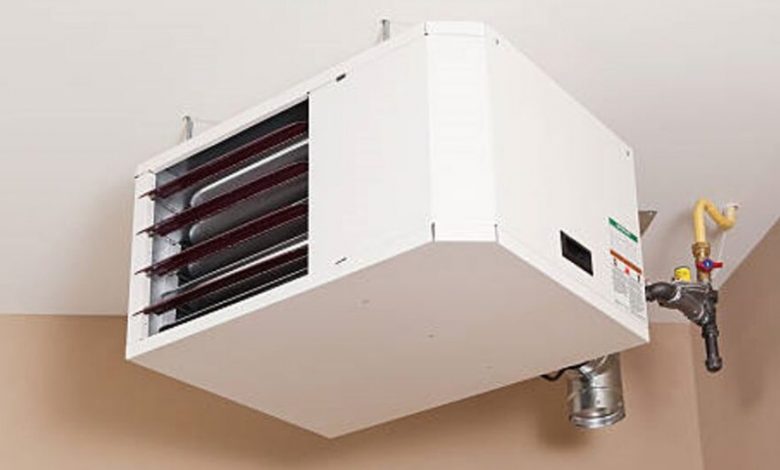Best Gas Garage Heaters of 2023

Whether you use your garage for hobbies during the colder months or for repairs that can’t wait until warmer weather, it’s better to be comfortable when you’re there. Instead of getting cold fingers, use the best gas garage heater to take the edge off the cold.
These easy-to-use, clean-burning heaters use natural gas or propane to heat your garage and keep you, your cars, and your tools warm when the temperature drops. This guide will help you pick the best gas garage heater.
Choose the Best Gas-Powered Garage Heater
A garage heater can be a great addition to a house, but not everyone knows how they work. When looking for the best gas garage heater for your garage, barn, or workshop, keep these things in mind. Some important things to think about are safety, fuel sources, and portability. Also, read Best Memory Foam Mattresses.
Type
- Gas garage heaters come in three main types: forced air, convection, and radiant. Here are some more details about how garage heaters use different ways to heat:
- Forced-air gas heaters pull cold air from the room, heat it, and then push it back into the room.
- Convection heaters, which are also called “blue flame” heaters, heat the air around them. This starts a cycle in which warm air rises and cool air comes to the heater.
- Radiant heaters are a great way to heat a workbench because they send heat to objects in the room. These heaters also come in two different styles: direct vent and ventless.
Direct vent heaters send their gases outside, while ventless heaters send their gases back into the room they are heating. Direct vent heaters cost more and are harder to set up, but ventless heaters can bother people who are sensitive to smells and fumes.
There are also heaters that don’t use electricity, like ones that burn kerosene.
Fuel Source
When picking a product based on how it’s powered, keep in mind that there are natural gas, electric, and propane gas garage heaters. All of them work well, but sometimes one might be better than the others.
Propane heaters might be a better choice for garages that aren’t connected to natural gas grids. Propane also burns cleanly, but you can buy it in bottles rather than in pipes. There are bottle swap stations at many gas stations, grocery stores, and home improvement stores where you can trade an empty tank for a full one.
It’s important to know that propane heaters and natural gas heaters can’t be switched out. Each type of heater has different-sized nozzles or jets that send gas to the flame. For example, you wouldn’t want to use a propane tank on a natural gas heater without a conversion kit.
Keep in mind that there are electric garage heaters if you’d rather not use fossil fuels. These options can be used to heat both small and large garages. They can be moved around or mounted on the wall. Portable electric heaters are light and usually have handles so you can take them wherever you need heat. Wall-mounted heaters are semi-permanent and easy to set up so you can have heat all the time. Also, read Best Water Storage Containers.
Freestanding vs. Mounted
The best gas garage heaters may depend on whether you want a unit that stands alone or one that is attached to the wall. Users can put freestanding heaters wherever they want, which lets them focus the heat in a certain area. This can be a big plus, especially if you are using a small heater in a large room.
Mounted units don’t move, which has both good and bad points. Most of the time, these units are put up off the ground, which keeps them safe and out of the way. As long as they can heat the whole room, they are a very convenient choice. If they’re too small, though, the garage will have cold spots.
Capacity to Heat
When looking for the best garage heater, you should pay attention to how much heat it can put out. The size of a heater, measured in BTUs (British Thermal Units), can help you figure out where it will work best.t.
Less firepower will be needed for garages with less space. A 30,000-BTU unit is often more than enough for an attached one- or two-car garage. If you only need heat in a small area, like above a workbench, you might only need 5,000 BTUs.
Safety
The best gas garage heaters burn cleanly, work well, and are easy to use, but they aren’t completely safe. When a gas heater is put in a garage, there is a higher chance of accidents and injuries.
Many gas garage heaters have safety features like child safety locks that make it hard for a child to accidentally turn on the heater. Also, low oxygen shutoffs will turn off the heater if safe combustion can’t happen because there isn’t enough oxygen.
It’s also very important to make sure that the carbon monoxide detectors in the home and garage are working properly. When gas heaters are well-maintained and working right, they have a “ideal burn” that doesn’t put anyone at risk of getting sick from carbon monoxide.
But heaters that don’t work well don’t burn as well and can build up CO, which is dangerous. A carbon monoxide detector will let you know if dangerous levels of carbon monoxide are building up in your home or garage. This can happen for a number of reasons. Carbon monoxide doesn’t have a colour or smell, so these detectors are sometimes the only way to know there’s a problem.
Last, it’s important to keep things that can catch fire away from a heater. There are flammable items, liquids that can catch fire, and other dangerous things in garages that can start a fire if they are near a gas heater. Also, read Best Home Cleaning Services.
Installation
When shopping, you might think about how easy or hard it would be to instal a certain gas garage heater. People who want to take a heater out of the box and turn it on right away might like a portable one that screws onto a propane tank. If you want a more permanent solution, you might want to go with a mounted unit, which will take more work to set up.
Mounted units often need special brackets that attach to the ceiling or wall in order to be installed. Also, if these units vent outside, the exhaust pipe needs to go through a hole in the wall. If you need to connect to gas pipes, it might be best to hire a plumber to do it.
Extras
Depending on the style, they have features that make them more useful or just easier to use.
Mounted units that work with thermostats outside of the garage make it much easier to control the temperature in the garage. By setting the thermostat to the temperature you want, the heater will turn on and off to keep the room at that temperature. Also, remote controls make it easier to change the temperature.
For portable units, temperature control knobs let users adjust the amount of heat and fuel used by the flame to get the most out of a bottle of propane.
Best Gas Garage Heaters
It is now easier to find the best gas garage heater. Here is a list of some of the best things you can buy. Keep in mind the most important things to think about when shopping as you compare these products. From choosing the best fuel source to picking the right size, the options below have something for every garage.
1) Mr. Heater 30,000 BTU Vent
The 30,000-BTU Natural Gas Heater from Mr. Heater is our pick for the best gas heater for garages. It is worth looking into for small to medium-sized garages. This blue-flame convection heater can heat up to 1,000 square feet of space and spreads the heat out evenly. It comes with the parts you need to hang it on the wall or stand it up on its own.
This garage heater doesn’t need a vent, and it’s easy to set up. It’s also easy to start because it has an electronic ignition. It has a switch that lets the user control the temperature with a variable output. It also has a sensor that turns the unit off when there isn’t enough oxygen, and because it uses convection, it’s safer to instal in smaller spaces than a radiant heater.
Specifications
- Type: Convection heater/blue flame (ventless)
- Fuel source: Natural gas
- BTUs/heating capacity: 30,000 BTUs
Pros
- Heats an area of up to 1,000 square feet and spreads the heat evenly.
- 30,000 BTU of natural gas heat through blue flame convection without a vent.
- Includes legs for use on its own and hardware for mounting on the wall.
Cons
- Works best under elevations of 4,500 feet
- Not for bathrooms or RVs, which have small, closed spaces.
2) Mr. Heater F232000 MH9BX Buddy Propane Radiant Heater
A small budget isn’t needed to heat a small room. This unit can be hooked up to a standard-size propane tank using an adapter hose and small 1-pound propane bottles.
This radiant propane garage heater puts out between 4,000 and 9,000 BTUs and can heat up to 225 square feet. This makes it a good choice for small shops and one-car garages. This portable garage heater doesn’t have a vent, so it can be used inside or outside. It’s also nearly 100% efficient, so it won’t waste fuel. This garage heater will also turn off if it falls over, if the pilot light goes out, or if it senses that there isn’t enough oxygen in the room.
Specifications
- Type: Radiant (ventless)
- Fuel source: Propane
- BTUs/heating capacity: 4,000 to 9,000 BTUs
Pros
- Gas heaters that are very portable, cheap, and easy to use
- Uses a 1-pound propane cylinder or a standard propane tank through an adaptor.
- Ventless design lets it be used both inside and outside
- It can heat up to 225 square feet, which is perfect for a tent, camper, or garage.
Cons
- At most, it only burns for 3 hours.
3) Mr. Heater F260560 Big Maxx Natural Gas Unit Heater
When a small, temporary fix for a large garage or shop won’t do. This natural gas heater with 80,000 BTUs can heat rooms up to 2,000 square feet in size. The fan in the back of the unit pulls in cold air, pushes it over a heat exchanger, and then forces it into the room to quickly heat it up.
The Big Maxx needs 8 feet of space underneath it, so it comes with the brackets you need to hang it from the ceiling. It has propane conversion kit so that people can switch from gasoline to propane if they want to. This unit is controlled by a thermostat and has direct ventilation, but the parts you need to do both are sold separately.
Specifications
- Type: Forced air (ventless)
- Fuel source: Natural gas
- BTUs/heating capacity: 80,000 BTUs
Pros
- 80,000 BTU natural gas supply; heats up to 2,000 square feet
- Wall or ceiling mountable and comes with brackets
- Ventilation system with a motor that can be used horizontally or vertically
- The forced-air system heats quickly, even in big rooms.
- Comes with a kit to change to propane
Cons
- At least 8 feet of space between the base and the floor.
- For thermostatic control and direct venting, you need to buy two different things.
4) Dyna-Glo 30,000 BTU Natural Gas Vent Free Wall Heater
Dyna-Natural Glo’s Gas Vent Free Wall Heater is worth thinking about if you want to get the most out of a gas garage heater. This blue-flame heater with 30,000 BTU can heat up to 1,000 square feet with warm, even convection heat. And because it burns with 99% efficiency, this natural gas heater is a cheap way to stay warm.
This heater doesn’t need a vent, and it comes with the hardware you need to hang it on the wall. It also has three heat settings that can be changed on the top of the unit, so users can set the temperature to their liking. There is a battery-powered electronic ignition that makes it easy to start the unit, and a low-oxygen cutoff switch that turns the unit off when it senses that there isn’t enough oxygen. Also, read Best Gas Fireplace Inserts.
Specifications
- Type: Convection/blue flame (ventless)
- Fuel source: Natural gas
- BTUs/heating capacity: 30,000 BTUs
Pros
- Can heat up to 1,000 square feet of space.
- Burns 99.99 percent of the time.
- The battery-powered ignition and low-oxygen cutoff switch make it easy to start.
Cons
- There is no thermostat.
5) Mr. Heater F260550 Big Maxx Natural Gas Unit Heater
Not every unit that hangs from the ceiling is big and strong. The Mr. Heater F260550 Big Maxx Natural Gas Unit Heater is a good choice for rooms that are about 1,000 square feet. This forced-air heater puts out 50,000 BTUs of heat, which is enough to quickly heat garages and small barns that are up to 1,250 square feet in size. And the ceiling brackets that come with it make it easy to hang it from the ceiling.
The Big Maxx kit also comes with the tools needed to switch this heater from natural gas to propane, so the user can choose which fuel to use. This unit does need a ventilation kit and a thermostat, which you have to buy separately.
Specifications
- Type: Forced air (vented)
- Fuel source: Natural gas
- BTUs/heating capacity: 50,000 BTUs
Pros
- gas output of 50,000 BTU for 1,250 square feet
- The thermostat and other controls are easy to reach.
- Ventilation system with a motor that can be used horizontally or vertically
- Gas or propane can be used to power this industrial-style heater.
Cons
- At least 8 feet of space between the base and the floor.
- The thermostat and ventilation kit are two different things you buy.




